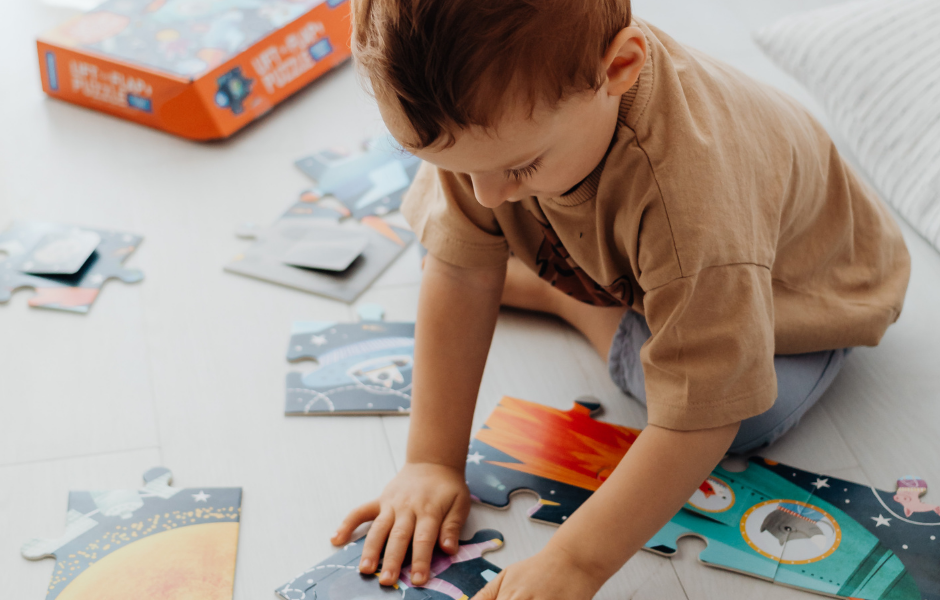As a mother of two energetic kids, now ages 6 and 10, I know all too well the nightly struggles of putting a toddler to sleep on time. Bedtime often felt like an endless negotiation, with my little ones refusing to wind down or suddenly needing “just one more” story.
I vividly remember scouring the internet for answers, typing things like, “how to put a toddler to sleep in 40 seconds,” hoping for a miracle solution. But what I learned over the years is that there’s no magic trick; just small, consistent changes that can make a world of difference.
Research shows that toddlers need 11 to 14 hours of sleep in a 24-hour period, according to the Sleep Foundation. If you’re dealing with a toddler who doesn’t want to sleep or refuses to sleep, don’t lose hope. The five tips I’m about to share are rooted in personal experience and backed by research, giving you actionable ways to create peaceful and consistent bedtimes.

Lavender Oil Foot Massage
When bedtime used to feel like a never-ending struggle, I stumbled upon the soothing power of lavender oil. This simple yet effective technique became a part of our nightly routine, helping my toddlers relax and drift off on time.
How to Do It
Start by creating a peaceful sleep environment. Dim the lights, eliminate distractions, and, if you like, play soft music to set a calming tone. Take a few drops of pure lavender oil and mix it with a carrier oil, like coconut or almond oil, to ensure it’s safe for your toddler’s skin. Warm the oil between your palms and gently massage your toddler’s feet using slow, circular motions.
Why It Works
Lavender oil is well-known for its relaxing properties and has been shown in studies to reduce stress and improve sleep quality. A research highlights how lavender aromatherapy can aid in achieving better sleep.
The act of massaging your toddler’s feet stimulates pressure points and relaxes tense muscles, making it especially effective if your toddler refuses to sleep or is overtired.
A Warm Lavender Bath
Bath time has always been a soothing part of our bedtime routine, but when I started adding lavender essential oil to the water, it became a true game-changer. If your toddler doesn’t want to sleep or struggles to transition from playtime to bedtime, this simple yet effective ritual can help create the calm they need.
How to Do It
Run a warm bath about 30–40 minutes before bedtime. Add 2–3 drops of lavender essential oil, ensuring it’s well-diluted for your child’s sensitive skin. Allow your toddler to soak for 10–15 minutes, enjoying the warmth of the water and the calming scent of lavender.
Why It Works
The combination of warm water and lavender helps to relax both the body and mind. Lavender, on the other hand, is known for its ability to reduce anxiety and promote relaxation, making it perfect for toddlers who experience separation anxiety sleep challenges or feel overtired.
Personally, I noticed that a warm lavender bath became the ultimate signal that bedtime was near. On nights when my toddler refused to sleep or seemed restless, this calming ritual helped them transition into their bedtime routine more smoothly.
Establish a Consistent Bedtime Routine
One of the best ways to figure out how to put a toddler to sleep on time is by sticking to a predictable bedtime routine. I noticed this firsthand when my toddlers were younger. Creating a consistent series of steps before bed not only helped them wind down but also made bedtime battles a thing of the past.
How to Do It
Start by designing a simple and calming bedtime routine you can follow every night. In my home, this involves brushing teeth, changing into pajamas, reading a bedtime story, and finishing with a soothing lullaby. The key is to start at the same time every night to regulate your toddler’s internal clock.
According to the American Academy of Sleep Medicine, a consistent bedtime schedule helps children fall asleep faster and improves overall sleep quality. Make sure the routine is screen-free and avoid overstimulating activities to keep things peaceful.
Why It Works
Toddlers often resist sleep because of overstimulation or difficulty transitioning from play to rest. A consistent bedtime routine creates a sense of predictability, signaling to your child’s mind and body that it’s time to sleep.
For me, this method became a lifesaver. I remember nights when my toddler didn’t want to sleep, but once we started following the same routine every night, bedtime became much smoother.
If you’re struggling to figure out how to put a toddler to sleep on time, consistency might just be the key to peaceful evenings for your whole family.

Create a Calming Sleep Environment
I used to wonder why my toddlers were restless, even after a bedtime routine, until I started making small but impactful changes to their bedroom setup. If your toddler doesn’t want to sleep or keeps waking up at night, creating a calming sleep environment can help immensely.
How to Do It
Ensure your toddler’s bedroom is quiet, dark, and cool to create the perfect environment for sleep. Use blackout curtains to block out external light, especially during daylight savings when the evenings stay brighter.
A white noise machine can be a great tool to drown out background noise like traffic or household sounds. Keep the room at a comfortable temperature, ideally between 16–20°C. Additionally, remove any stimulating toys or electronic devices that might distract your child from sleeping.
My toddler refused to sleep when even the smallest bit of light entered the room. The curtains, combined with the white noise machine, helped create a cozy and peaceful atmosphere that encouraged them to fall asleep faster.
Why It Works
A calm and distraction-free sleep environment signals to your toddler’s body that it’s time to rest. Darkness promotes the natural production of melatonin, the hormone that regulates sleep. The quiet and cool atmosphere ensures your child stays comfortable throughout the night, reducing the chances of frequent wake-ups.
Limit Screen Time Before Bed
When I was learning how to put a toddler to sleep on time, I discovered that screen time was one of the biggest culprits behind late bedtimes. The blue light emitted by devices like tablets and TVs can interfere with melatonin production, making it harder for toddlers to feel sleepy.
If your toddler refuses to sleep or has trouble settling down, reducing screen time before bed can make a noticeable difference.
How to Do It
Establish a no-screen rule at least one hour before bedtime. Instead of allowing screen-based activities, introduce calming alternatives like reading a bedtime story, drawing, or playing with non-electronic toys.
If your child is accustomed to screens before bed, gradually reduce their usage by setting specific limits, like turning off the TV after dinner and transitioning to quieter activities.
In my own experience, transitioning away from pre-bedtime screens wasn’t easy at first. My kids loved watching cartoons right before bed, and when I initially replaced that time with storytime, they resisted. But after a week of consistency, their bedtime routine became smoother, and they started falling asleep earlier.
Why It Works
Limiting screen time before bed helps reduce exposure to blue light, allowing your child’s body to produce melatonin naturally. This hormone regulates the sleep-wake cycle and helps your toddler transition more easily from wakefulness to sleepiness.
Wind Down Early to Prevent Overtiredness
If your overtired toddler won’t sleep, bedtime can quickly turn into a challenge. I’ve been in those frustrating moments when my toddler refused to sleep, becoming hyperactive and restless because we missed the ideal bedtime window. To avoid this, winding down early became a key part of our bedtime routine.
How to Do It
Start preparing for bedtime at least an hour beforehand. Turn off screens (which can impact melatonin production) and avoid stimulating activities. Instead, engage your child in calming routines like reading a short story, doing a puzzle, or enjoying a warm lavender bath. Keep the sleep environment cool and comfortable, especially if your toddler sweats in sleep.
Why It Works
Overtiredness can cause a surge in stress hormones like cortisol, making it harder for toddlers to settle down. Creating a consistent wind-down period helps regulate their energy and cues their brain that bedtime is approaching.
When I started implementing this, I noticed a significant difference in how quickly my toddler fell asleep on time.
Comfort Them Through Separation Anxiety
If your child experiences toddler separation anxiety sleep struggles, they might cry, cling, or outright refuse to settle. My own toddler would repeatedly call out for me after I left the room, and it was clear that reassurance was needed to help them feel secure.
How to Do It
To ease anxiety, establish a calming bedtime routine that incorporates reassurance. Spend time sitting by their bed until they’re drowsy, then gradually reduce your presence over time.
Introducing a soothing bedtime object, like a stuffed animal, can also help. Additionally, using a white noise machine or soft lullabies can provide comfort and distract from feelings of separation.
Why It Works
Separation anxiety often peaks at bedtime when toddlers feel most vulnerable. By offering consistent reassurance, they develop confidence in falling asleep independently. When my toddler didn’t want to sleep, this method helped us establish trust while encouraging gradual self-soothing skills.
The 40-Second Sleep Trick
Looking for a quick and effective way to tackle bedtime? The popular method on how to put a toddler to sleep in 40 seconds might be just what you need. Although it may not work for everyone, I’ve had some success with it during particularly restless nights.
How to Do It
Lay your child down in a calming sleep environment. The room should be quiet, dark (use blackout curtains), and comfortable. Gently stroke their forehead in slow, rhythmic motions, moving outward from the center. Speak softly in a repetitive, soothing tone or hum a calming lullaby. The gentle touch combined with your voice can help them relax deeply.
Why It Works
This method taps into the power of touch and rhythm to soothe your child’s nervous system. It’s especially useful if your toddler refuses to sleep or struggles with bedtime anxiety. For me, it became a go-to trick when my kids were overtired or had difficulty calming down.
Final Thoughts
As a mom who has dealt with the ups and downs of toddler sleep training, I can personally vouch for how these tips can transform bedtime struggles into a more peaceful experience. Not only did they help my kids get to sleep on time, but they also gave me the chance to recharge and ensure everyone got the rest they needed.
By creating a calming bedtime routine, you can ensure that your toddler gets the sleep they need while also supporting your own well-being. For more helpful tips, visit our blog and join our supportive parenting community!
You’ll Also Like:
- How to Reduce Belly Fat After Normal Delivery
- Find Your New Identity as a Mom!
- Struggles All Stay-at-Home Mother Face
What to do when a toddler won’t go to sleep?
Establish a calming bedtime routine (bath, book, lullaby). Ensure a comfortable sleep environment (dark, cool, quiet). Limit screen time at least an hour before bed. Stick to a consistent sleep schedule. Use calming techniques like gentle patting if needed.
Why is my 2-year-old so hard to put to sleep?
Common reasons include developmental changes (independence, separation anxiety), teething discomfort, fear of the dark, overstimulation from a busy day, or late naps disrupting bedtime.
Are there any foods that help toddlers sleep through the night?
Sleep-friendly foods include bananas (magnesium, potassium for muscle relaxation), Oatmeal (boosts serotonin for relaxation), Whole grains (steady blood sugar, melatonin production), Cherries (natural melatonin source) ,Turkey (tryptophan for sleepiness) and Milk (calcium aids melatonin production).









